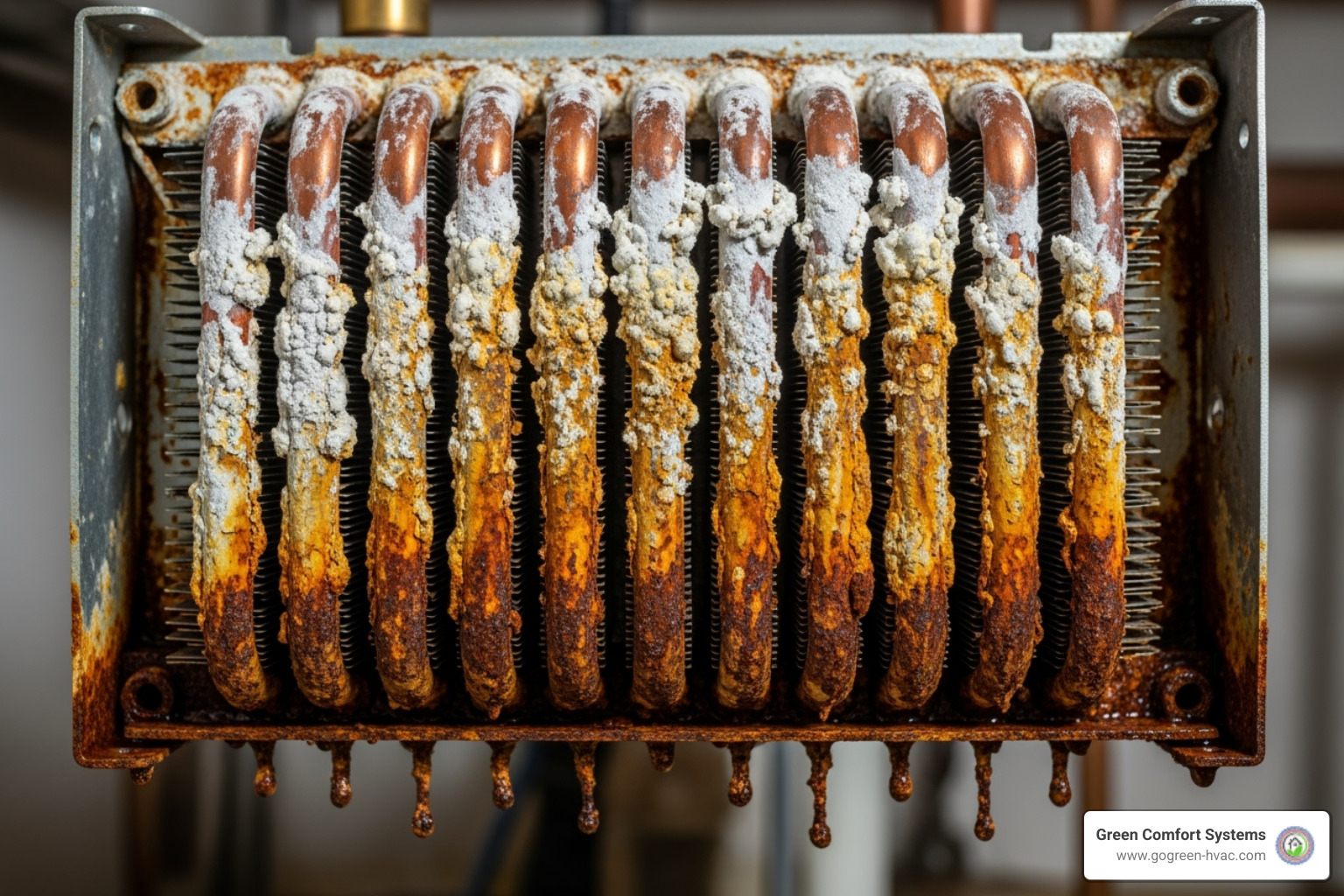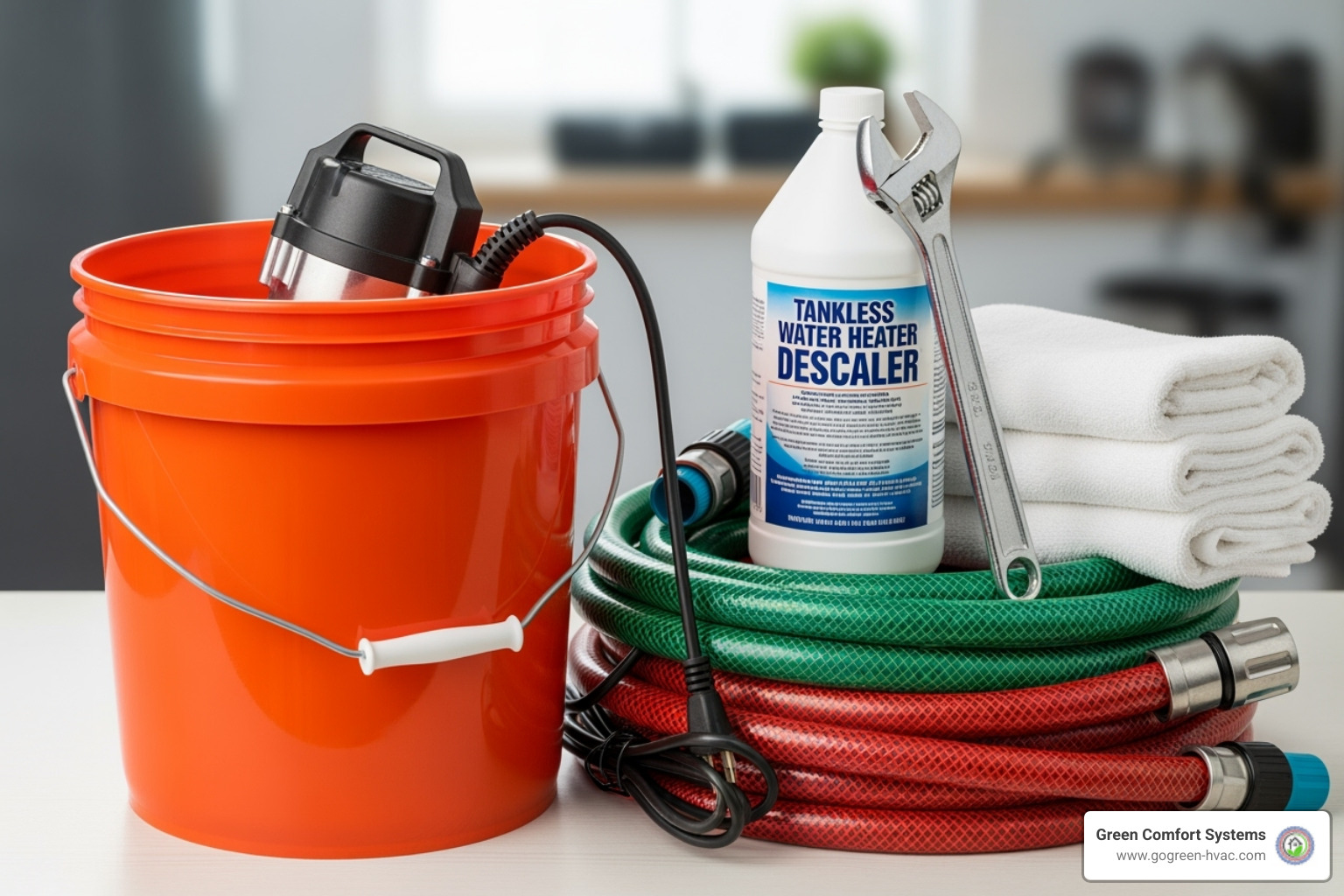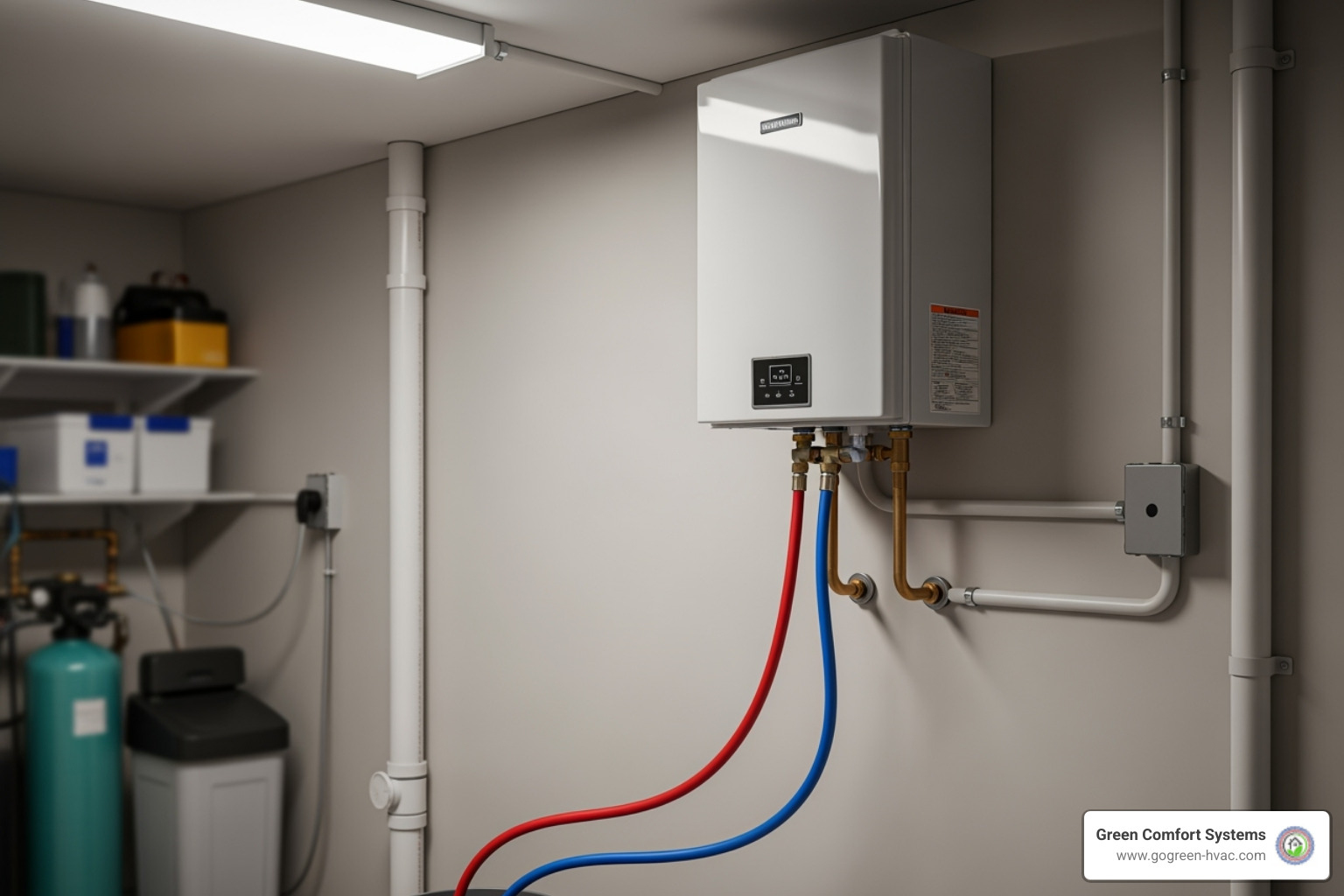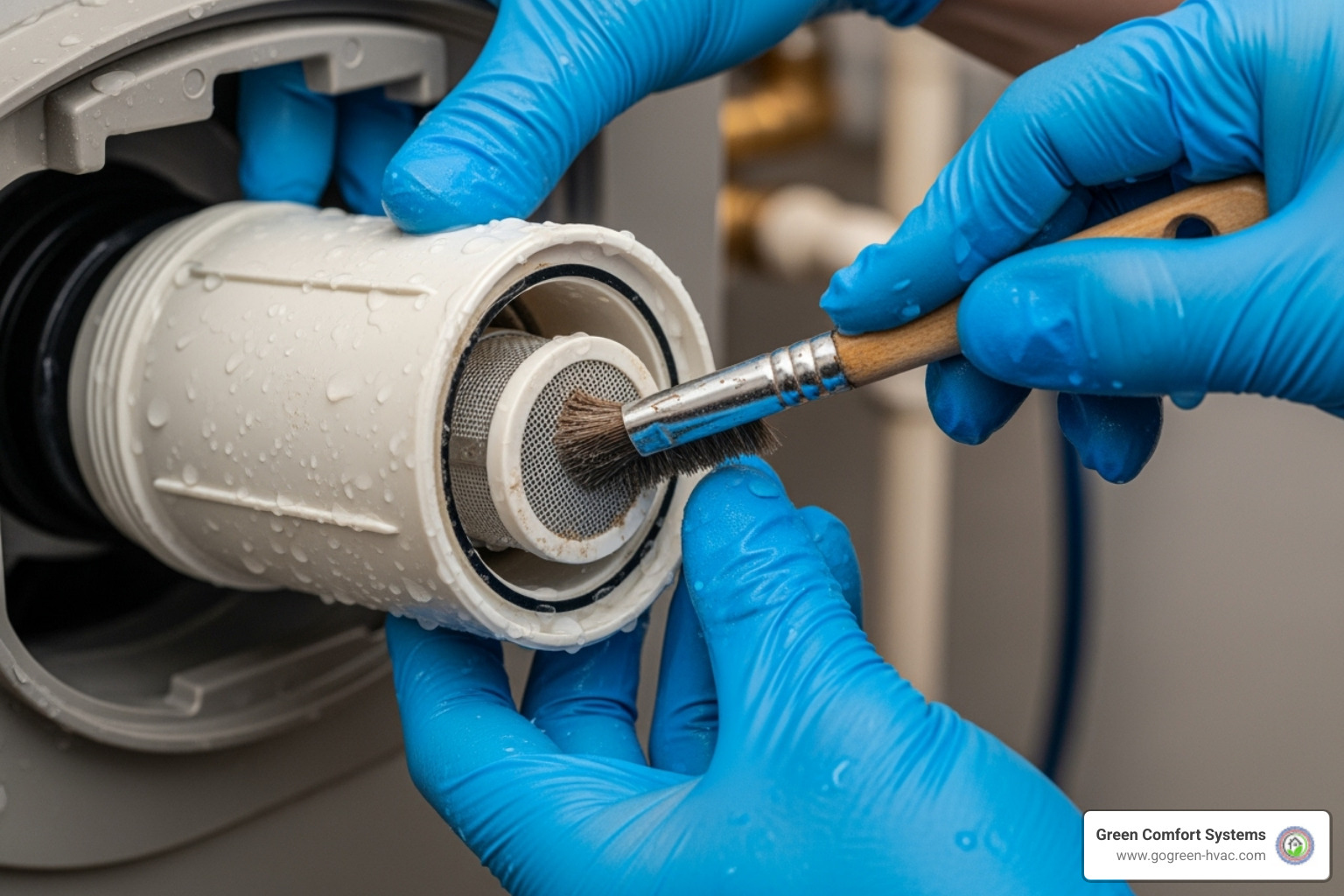Don't Get Left in the Cold: Essential Tankless Water Heater Maintenance Tips

Why Tankless Water Heater Maintenance Is Critical for Rosedale Homeowners
Tankless water heater maintenance is essential for keeping your on-demand hot water system running efficiently and lasting its full 20-year lifespan. Without proper care, mineral buildup can damage your heat exchanger, reduce water flow, and cut your unit's life in half.
Quick maintenance checklist for tankless water heaters:
- Annual flushing - Remove mineral deposits with vinegar or descaling solution
- Clean water filters - Remove and rinse inlet filters every 3-6 months
- Check air intake - Clean air filter annually with soft brush
- Inspect for leaks - Look for water around pipes and connections
- Test pressure relief valve - Ensure proper operation and safety
- Professional service - Schedule yearly inspection for gas pressure and electrical components
Your tankless water heater saves you money by lasting years longer than traditional tank heaters and reducing energy bills by 20-30%. But these savings only happen with regular maintenance.
Hard water areas like parts of Maryland may need flushing every 3-6 months instead of annually.
The biggest mistake homeowners make? Skipping annual maintenance. This leads to mineral buildup that can destroy your heat exchanger - the most expensive component to replace.
Whether you tackle basic maintenance yourself or hire a professional, staying on schedule protects your investment and ensures endless hot water when you need it most.

Why Regular Maintenance is Non-Negotiable
Your tankless water heater is an impressive piece of technology. It delivers endless hot water on demand, uses 20-30% less energy than traditional tank heaters, and can last up to 20 years with proper care. That's nearly double the lifespan of a conventional water heater!
But here's what many homeowners don't realize: these amazing benefits aren't guaranteed. They depend entirely on one critical factor - regular tankless water heater maintenance.
Think of your tankless unit like a high-performance car. It's built to deliver outstanding results, but only if you give it the routine care it deserves. Skip the maintenance, and your energy-saving powerhouse can quickly become an unreliable money pit.
Regular maintenance delivers real benefits that you'll notice immediately. Your water pressure stays consistent, your energy bills stay low (because your unit isn't working overtime), and you avoid those heart-stopping emergency repair calls. Most importantly, you get to enjoy that perfect hot shower every single morning without worry.
When you stay on top of maintenance, you're also preventing costly repairs before they happen. A simple annual flush costs far less than replacing a damaged heat exchanger or dealing with a complete system failure.
On the flip side, neglecting maintenance invites serious problems. Mineral buildup (called scale) starts forming inside your unit from day one. This buildup reduces efficiency, clogs pipes, and can cause premature failure. Even worse? Skipping maintenance often voids your warranty, leaving you to cover expensive repairs out of pocket.
For more details on how these systems work, check out the benefits of on-demand water heaters. And if you need professional help with your system in the Rosedale area, our team specializes in Tankless Water Heater Repair Rosedale MD.
The consequences of skipping tankless water heater maintenance
Let's be honest about what happens when you ignore your tankless water heater's maintenance needs. It's not pretty, and it's definitely not cheap.
The main villain in this story is mineral buildup, also known as scale. These are calcium and magnesium deposits that naturally occur in your water supply, especially if you have hard water (which is common throughout Maryland).

These minerals stick to your heat exchanger like barnacles on a boat hull. Imagine trying to boil water in a kettle that's coated with a thick layer of rock - it takes more energy, takes longer, and eventually damages the kettle itself.
Scale buildup creates a domino effect of problems. First, you'll notice reduced water flow as minerals clog your pipes and filters. That refreshing morning shower starts feeling more like a disappointing trickle.
Next comes reduced efficiency. Those mineral deposits act like insulation, forcing your heat exchanger to work much harder to heat your water. Your energy bills creep up, erasing the savings you invested in a tankless system for in the first place.
The real nightmare scenario is heat exchanger damage. This is your unit's heart and soul - and the most expensive component. Scale buildup causes hot spots and stress that can crack or destroy the heat exchanger entirely. Replacing it often costs nearly as much as buying a new unit.
You'll also start getting tepid water instead of the hot water you expect. Your unit struggles to keep up, leaving you with lukewarm showers and frustrated family members. Modern units may even display system errors and shut down completely to protect themselves from damage.
All of this leads to a shorter service life. Instead of enjoying 20 years of reliable service, neglected units often fail after just 8-10 years. That's like throwing away half your investment.
Perhaps most frustrating of all, skipping maintenance typically voids your warranty. When your unit fails due to scale buildup, you'll be covering the full cost of repairs or replacement yourself.
How often should you service your unit?
The answer to "how often" depends mainly on your water quality. Hard water areas need more frequent attention because minerals build up faster.
Here's your maintenance schedule based on water type:
| Water Type | Maintenance Frequency | Notes |
|---|---|---|
| Hard Water | Every 6-12 months | Common in many Maryland areas. Minerals accumulate quickly and need regular removal. |
| Average Water | Annually | Most homes fall into this category. Annual flushing prevents serious buildup. |
| Soft Water | Every 2-3 years | If you have a water softener or naturally soft water, you can extend the interval. |
High usage households may need more frequent service regardless of water hardness. If you have a large family or use lots of hot water throughout the day, consider shortening your maintenance intervals.
Always check your manufacturer recommendations too. Your owner's manual may specify different intervals to keep your warranty valid. Some brands are stricter than others about maintenance requirements.
A simple trick? Schedule your annual flush when you change your clocks for daylight saving time. It's an easy way to remember this important task and keep your system running smoothly year after year.
Your Complete Guide to DIY Tankless Water Heater Maintenance
Here's the truth: tankless water heater maintenance doesn't have to break the bank. While professional service is always an option, much of the essential upkeep - especially the crucial flushing and descaling - is surprisingly manageable for most homeowners. If you're comfortable changing your car's oil or tackling basic home repairs, you can absolutely handle this.
But let's be crystal clear about something important: safety comes first, always. You'll be working around water, electricity, and possibly gas. Take your time, read through all the steps before starting, and never hesitate to call a professional if something doesn't feel right. A botched DIY job can void your warranty and create dangerous situations.
Think of it this way - you're not just saving money on service calls. You're also gaining that satisfying feeling of keeping your home running smoothly with your own two hands. Plus, once you've done it a few times, the whole process becomes second nature.
When you do need expert help - whether for complex repairs or just peace of mind - our team is here for you. Check out our Tankless Water Heater Repair Perry Hall MD services for professional support in your area.
Essential tools for tankless water heater maintenance
Getting organized before you start makes all the difference between a smooth maintenance session and a frustrating afternoon. The good news? You probably already have some of these items around the house.
Your shopping list starts with a 5-gallon bucket - this becomes your command center for holding and circulating the cleaning solution. You'll also need a submersible pump (a small utility pump works perfectly) to keep that solution moving through your system.
Two hoses are essential for creating the cleaning loop between your pump and the tankless unit's service ports. Regular garden hoses work fine for most units. An adjustable wrench handles any connection tightening, while plenty of towels keep things tidy.
For the actual cleaning, white distilled vinegar is your secret weapon. It's cheap, effective, and safe - you'll need about 3-4 gallons for a thorough flush. While commercial descaling solutions work too, vinegar does the job beautifully and won't hurt you if you accidentally splash some.
Don't forget about those small purge port valve caps - they're easy to misplace, and you definitely need them back where they belong. Handle them gently since they have rubber seals that keep everything watertight.

Having everything laid out and ready transforms what could be a chaotic process into a methodical, almost zen-like routine.
Step-by-Step: Flushing and Descaling Your Unit
This is the heart of tankless water heater maintenance - the deep clean that keeps mineral buildup from destroying your investment. Take it slow, follow each step carefully, and you'll do great.
1. Power Down
Before you touch anything else, cut the power. This isn't negotiable - it's about keeping you safe and protecting your unit.
For electric units, head to your main electrical panel and flip off the breaker that feeds your water heater. For gas units, find that gas shut-off valve near your tankless heater and turn it completely off. No shortcuts here - we want zero chance of accidents.
2. Isolate the Unit
Now we're stopping water flow so you can work without creating an indoor swimming pool. Find the hot and cold water valves connected to your unit - they're usually clearly marked or color-coded.
Turn both valves completely off. Next, you'll want to relieve any built-up pressure in the system. Some units have a purge valve with a T-shaped handle you can pull up. If not, open a nearby hot water faucet until the flow stops, then close it. This prevents surprise water sprays when you start connecting hoses.
3. Connect Hoses
Here's where your setup starts looking like a science experiment - in a good way. Your tankless unit has service ports (sometimes called purge valves) specifically designed for maintenance. They're typically on both the cold water inlet and hot water outlet lines.
Carefully remove the caps from these service ports - those little rubber sealing discs need to stay put, so handle them gently. Connect one hose to the cold water service port and run the other end to your bucket. Connect the second hose to the hot water service port, also leading to the bucket.
Open those purge port valves by turning them perpendicular to your main water valves. You've just created a closed cleaning loop.

4. Circulate Descaler
Time for the main event. Fill your bucket with about 3-4 gallons of undiluted white vinegar. Yes, your garage might smell like a pickle factory for a while, but using vinegar as a descaler is incredibly effective and completely safe.
Drop your submersible pump into the vinegar, making sure it's fully submerged. Connect the hose from the cold water service port to your pump's discharge. The hose from the hot water port should return to the bucket, completing your cleaning circuit.
Fire up that pump and watch the magic happen. You'll see vinegar circulating through your tankless heater and back to the bucket. Let it run for 45-60 minutes - this gives the acid time to dissolve all those stubborn mineral deposits that have been building up inside your heat exchanger.
5. Flush with Fresh Water
Once your timer goes off, it's rinse time. Turn off the pump and carefully disconnect the hose from the cold water service port. Let the vinegar solution drain out completely.
Now for the fresh water flush. Reconnect that cold water hose, but this time crack open your main cold water valve slightly. Let fresh water run through the system and out the hot water service port for about 5-10 minutes. This washes away any remaining vinegar and loosened mineral debris.
6. Restore and Restart
You're in the home stretch! Close those purge port valves and disconnect all your hoses. Replace the service port caps carefully - snug but not overtightened.
Open your main hot and cold water valves slowly, then restore power by turning the gas back on or flipping that circuit breaker. Finally, open several hot water faucets around your house. You'll hear some gurgling and sputtering as air works its way out - that's completely normal. Let the water run until the flow is steady and clear.
Congratulations! Your tankless water heater just got a spa day, and it's going to thank you with years of reliable, efficient service.
Inspecting Key Components
Beyond that annual deep clean, your tankless water heater has several components that need regular attention. Think of these as the routine checkups that prevent bigger problems down the road.

The inlet water filter is your first line of defense against sediment and debris. It's usually located near the cold water inlet and comes out easily for cleaning. A quick rinse under cold water and gentle brushing removes buildup that could otherwise clog your system.
For gas units, the air intake filter is crucial for proper combustion. A dirty filter forces your unit to work harder and can cause overheating. Most clean easily with a vacuum or damp cloth - just make sure it's completely dry before reinstalling.
If you have a condensing unit, the condensate trap needs periodic attention too. This little component catches the moisture produced during operation, and it can develop sludge over time. Remove it, empty the contents, and clean thoroughly before replacing.
Your pressure relief valve is a critical safety device that deserves annual testing. Gently lift the lever for a few seconds - water should flow freely through the discharge pipe. If nothing happens or if the valve leaks afterward, call a professional for replacement.
During these inspections, always check for leaks around pipes, connections, and the unit itself. A small drip today can become major water damage tomorrow. Also, familiarize yourself with your unit's error codes - they're often your first warning that maintenance is needed.
While cleaning external components is perfectly safe for DIY maintenance, internal work like burner assembly cleaning should always be left to licensed professionals. It's not worth the safety risk or warranty concerns.
Frequently Asked Questions about Tankless Water Heaters
We love hearing from homeowners about their tankless water heaters! Over the years, we've noticed the same questions come up again and again. Let's explore the most common ones and give you the straight answers you're looking for.
How does water hardness affect my maintenance schedule?
Water hardness is absolutely the biggest factor in determining how often you'll need to perform tankless water heater maintenance. Think of hard water as nature's way of testing your patience - and your water heater!
Hard water is loaded with dissolved minerals, mainly calcium and magnesium. These minerals aren't harmful to drink, but they're terrible news for your tankless unit. When hard water gets heated up, those minerals decide to take up permanent residence on your heat exchanger, forming that crusty white buildup we call scale.
The harder your water, the faster this happens. If you live in an area with particularly hard water (and many parts of Maryland definitely qualify), you might find yourself flushing your unit every 3 to 6 months instead of annually. It sounds like a lot of work, but trust us - it's way better than replacing a damaged heat exchanger!
On the flip side, if you've got naturally soft water or you've invested in a water softener system, you're in luck. These systems actively remove those troublesome minerals before they ever reach your tankless unit. With soft water, you might be able to stretch your maintenance schedule to every 2 to 3 years. That's a pretty sweet deal for what amounts to a relatively small upfront investment.
The key is knowing your water. You can get a simple water test kit from most hardware stores, or better yet, have a professional test your water hardness levels. Once you know what you're dealing with, you can plan your maintenance schedule accordingly.
Can I improve the time it takes for hot water to reach the tap?
Ah, the age-old "hot water lag" question! Here's the thing - this issue usually has nothing to do with your tankless water heater's performance or maintenance needs. Your unit is probably heating water just fine. The real culprit? Good old-fashioned distance.
Even though your tankless unit heats water instantly, that hot water still has to travel through all the pipes from the heater to your faucet. The farther apart they are, the longer you'll wait. It's simple physics, really.
But don't worry - there are some clever solutions! Recirculation systems are probably your best bet. These systems keep a small amount of hot water constantly circulating through your pipes, so hot water is always just a turn of the handle away. Some newer tankless units even come with built-in recirculating pumps that you can activate when needed.
For those really distant fixtures, point-of-use boosters can be a game-changer. These are small electric water heaters installed right under the sink that provide instant hot water for that specific location.
Insulating your hot water pipes won't make the water arrive faster, but it will help keep it hot during the journey. This reduces heat loss and can make a noticeable difference in your overall efficiency.
Sometimes the issue is actually water pressure rather than distance. If your home's water pressure is on the low side, it can contribute to slower delivery times. A quick check of your water pressure might reveal an easy fix.
Can I perform tankless water heater maintenance myself?
This is probably our most popular question, and the answer is a resounding yes - with some important caveats!
Many homeowners successfully tackle their own tankless water heater maintenance, especially the annual flushing we've been talking about. The process really is straightforward, and with the right tools and a bit of patience, most people find it quite manageable. We've had customers tell us they were surprised by how "very easy" it turned out to be.
But here's where we need to be honest with you: comfort level matters. If you're the type who enjoys weekend DIY projects and feels confident following detailed instructions, you'll probably do just fine. Basic mechanical skills and the ability to work methodically through steps are really all you need.
However, there are some important warranty considerations to keep in mind. While doing your own maintenance can save money, any damage you accidentally cause during the process could void your manufacturer's warranty. Always check your specific unit's manual for detailed instructions and any warranty requirements.
When should you call a professional? We always recommend picking up the phone if you're uncomfortable working with gas or electricity, if you encounter error codes that basic maintenance doesn't resolve, or if you suspect any kind of gas leak or safety issue. Some tasks, like cleaning the internal burner assembly, should only be handled by licensed professionals.
The choice is entirely yours! If you're a capable DIYer who enjoys tackling home projects, go for it. But if you'd rather have the peace of mind that comes with professional service, we're always here to help. For expert assistance in the Catonsville, MD area, you can visit our Tankless Water Heater Repair Catonsville MD page.
Whether you do it yourself or call in the pros, the most important thing is that the maintenance gets done regularly. Your tankless water heater will thank you with years of reliable, efficient service!
Protect Your Investment with Professional Care
Regular tankless water heater maintenance isn't just about checking off items on a to-do list - it's about protecting one of the smartest investments you've made for your home. When you stay on top of maintenance, your tankless unit will reward you with reliable performance for its full 20-year lifespan, consistently delivering that luxurious endless hot water you fell in love with.
The benefits of proper care extend far beyond just having hot water when you need it. Your well-maintained tankless system continues saving you 20-30% on energy bills compared to those old-fashioned tank heaters. It operates quietly and efficiently, never leaving you wondering if today's the day it might give up on you.
There's something deeply satisfying about knowing your home's systems are running smoothly. No surprise cold showers during your morning routine. No panic when guests arrive for the holidays. No hefty repair bills because mineral buildup destroyed your heat exchanger. That's the peace of mind that comes with consistent maintenance.
While we absolutely encourage homeowners to tackle basic maintenance tasks themselves, there are times when professional expertise makes all the difference. Our certified technicians at Green Comfort Systems bring years of experience and specialized tools that go beyond what most homeowners have in their garage. We perform thorough inspections that catch small issues before they become expensive problems.
Our team checks gas pressure on gas units, tests all safety features, and uses advanced diagnostic tools to ensure everything is operating exactly as it should. We also handle those more complex maintenance tasks - like cleaning internal burner assemblies - that should only be done by licensed professionals.
What sets us apart is our commitment to both your comfort and environmental responsibility. For every service call and installation we complete, we plant trees. It's our way of ensuring that keeping your home comfortable also contributes to a healthier planet.
Whether you're in Rosedale, Catonsville, Perry Hall, or anywhere across our service area, our team is ready to help you get the most from your tankless water heater investment. We understand these systems inside and out, and we're passionate about helping homeowners enjoy reliable, efficient hot water for years to come.
Ready to give your tankless water heater the professional care it deserves? Schedule your water heater service today and experience the difference that expert maintenance makes. Your future self will thank you every time you step into that perfect hot shower.
Book Expert Service Or Contact Us
Other Blogs





Get Financing Today
Get the comfort you deserve, without the financial stress.

Latest Blogs









